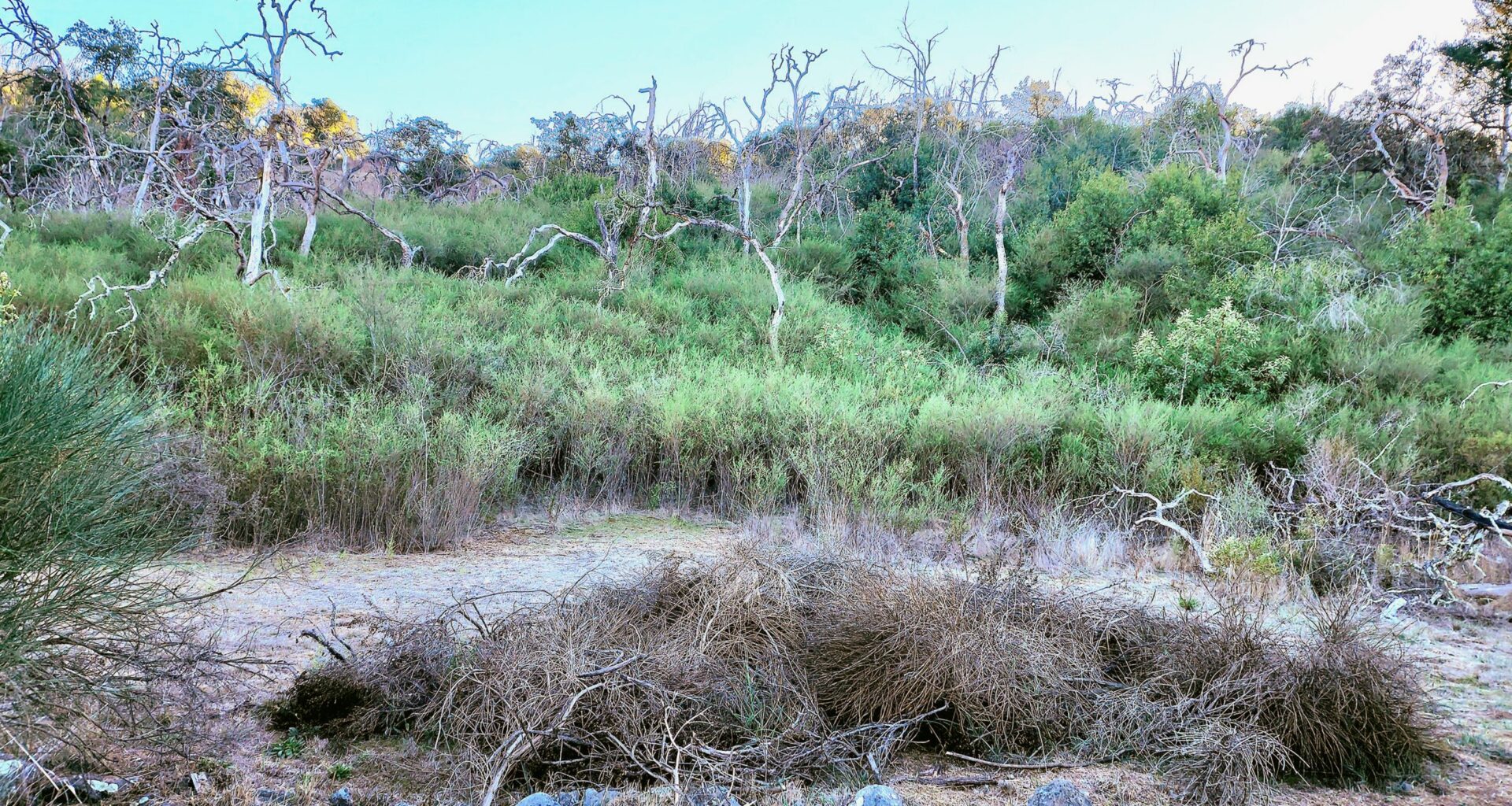SANTA ROSA, CA., 10/14/25 — Eight years ago, Cross Creek Road, a winding street in Santa Rosa’s upscale Fountaingrove development, was flanked by oak woodlands and grassy meadows. Then the 2017 Tubbs Fire burned through the city. The blaze – one of the worst wildfires in California history – killed 22 people, destroyed 5,643 homes and other structures, and burned the vegetation down to mineral earth. On Cross Creek Road, the heat was so intense that metal streetlights half-melted, tilting at odd angles like Dr. Seuss illustrations.
Fountaingrove was particularly hard hit, with entire neighborhoods reduced to smoking rubble. But today, Fountaingrove has recovered. New luxury homes rise magisterially where blackened foundations once stood. Almost 80% of the homes burned during the Tubbs Fire have been rebuilt. For many, that is indicative of the community’s indomitability, a sign that it is rising phoenix-like from the ashes.
But some wildfire experts warn intensive rebuilding in burned-out areas might not always be optimal, given that catastrophic wildfires tend to recur in some portions of the so-called wildland-urban interface (WUI) with alarming regularity. The Tubbs fire, for example, closely followed the same path as the 1964 Hanly Fire. Did time and a lack of institutional memory lead to Tubbs because a primary lesson – don’t rebuild where earlier fires raged – was lost?
The path of fire
Not necessarily, said Paul Lowenthal, a division chief and fire marshal for the Santa Rosa Fire Department. For one thing, the conditions in 1964 and 2017 were dramatically different, resulting in dissimilar wildfires.
“Yes, the footprints for Tubbs and Hanly were largely the same footprint, but that doesn’t mean the fires were the same,” said Lowenthal. “In 1964, it took several days to burn through the area. In 2017, it took about five hours.”
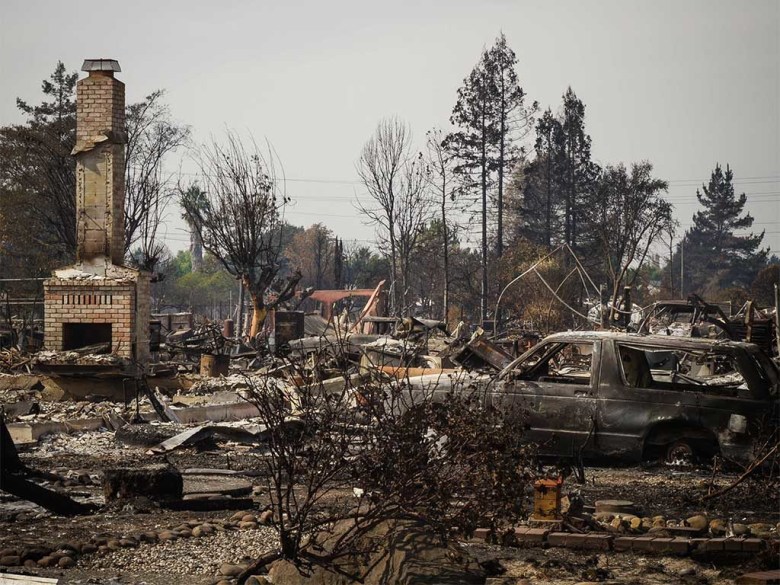 FILE: A home lies in ruins in the Coffey Park neighborhood of Santa Rosa, one of the areas hardest hit during the 2017 Tubbs Fire. (Photo by Benjamin Cosse/California National Guard)
FILE: A home lies in ruins in the Coffey Park neighborhood of Santa Rosa, one of the areas hardest hit during the 2017 Tubbs Fire. (Photo by Benjamin Cosse/California National Guard)
A big difference was wind. Extremely high and dry offshore winds drove the Tubbs Fire with unrelenting ferocity, making control virtually impossible. Few homes burned during Hanly because the fire wasn’t pushed by exceedingly high, hot winds and the area had been only minimally developed.
Also contributing to structure loss: most of the homes were not built to the fire-resistant codes now in place, said Lowenthal.
“After 2017, the city required that all rebuilt homes [in areas burned during Tubbs] had to be constructed to a much higher fire standard,” said Lowenthal.
That included an “ignition-free zone” of three feet around each house. Many of the homes burned during Tubbs ignited due to brush or trees crowding close to eaves and gutters, or deep leaf litter and flammable vegetation running close to home foundations.
Clearing the way
Carol Rice, the general manager of a fire policy-oriented consulting firm and an authority on wildfire behavior, fire codes and vegetation management, said Santa Rosa’s new codes remedy some but not all the existing fire risks.
“They’re good for ember intrusion into structures,” Rice said, “they’re somewhat adequate for flame impingement – when fire actually touches a house, such as under the eaves, and they’re weakest when it comes to radiant heat, say the heat from a nearby long-burning fire, or heat from an engulfed house that ultimately ignites a neighboring house. The problem is compounded by city policies that emphasize density, which reflect community priorities for new housing. You don’t have the wider spacing between homes that can reduce radiant heat.”
There is some low hanging fruit in fire risk mitigation: aggressively reducing fuel loads, a strategy Santa Rosa adopted after Tubbs.
“In 2019, the city adopted an ordinance that directly aimed at fuels,” said Lowenthal. “It stipulates removal of dead and fire-damaged trees along roadways and proscribes certain mulches and ground covers within 30 feet of homes – particularly ‘gorilla hair,’ a stringy redwood mulch that captures embers easily and creates fires that are extremely hard to extinguish. The Glass Fire [a very large 2020 Napa County wildfire that burned more than 1,500 structures] destroyed a lot of homes that had that mulch. Additionally, fighting those fires prevented firefighters from protecting other homes that might have been saved.”
The Glass Fire and a 2025 blaze that followed, the Pickett Fire, are an analogue to the Tubbs and Hanly Fires. Though the Pickett Fire was smaller than the Glass Fire, it re-burned through much of the same acreage.
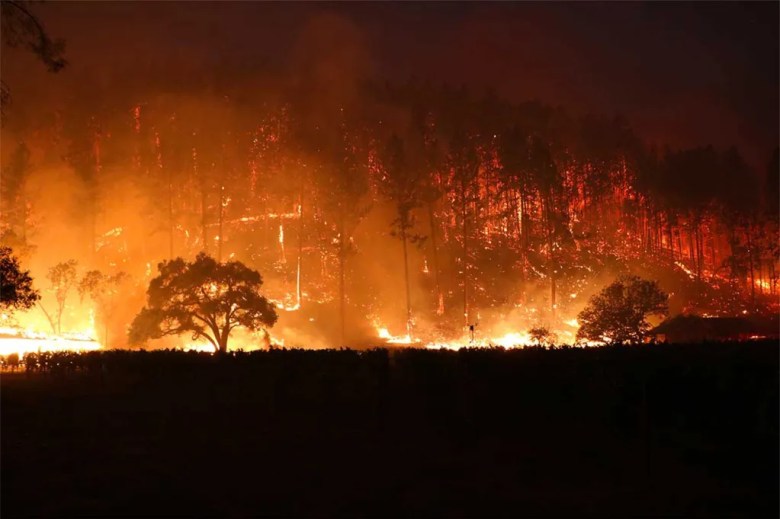
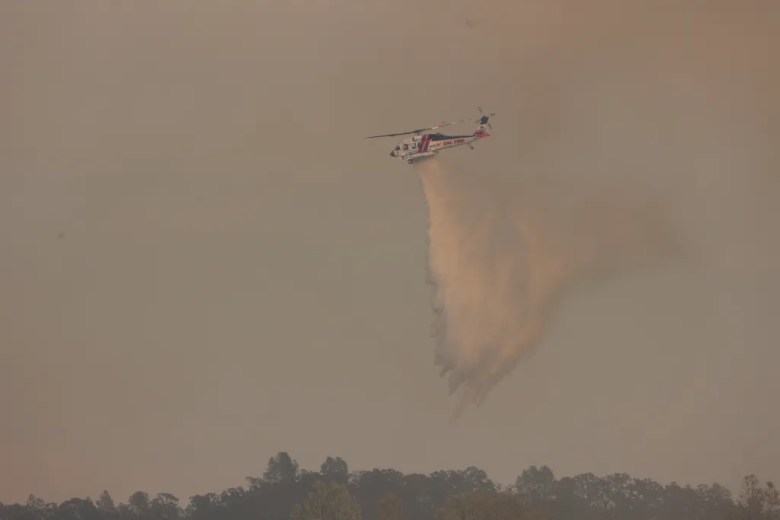
Left: The Glass Fire in September 2020 charred thousands of acres and homes in Sonoma County. Right: A Cal Fire helicopter drops water on the Pickett Fire in unincorporated Napa County, Calif. on Friday, Aug. 22, 2025. (Cal Fire via Bay City News)
Dead trees and gorilla hair notwithstanding, the primary target of the new Santa Rosa ordinance is Scotch broom – a perniciously invasive and highly flammable nonnative shrub that quickly blanketed burned zones following the Tubbs Fire.
“Thanks to Scotch broom, the fuel conditions in some areas are worse than they were before the fire,” Lowenthal said. “This ordinance allows us to address fuels aggressively, including requiring complete removal of Scotch broom within 30 feet of all roads.”
Prior to Tubbs, compliance with fire regulations was sometimes slack or even resisted by North Bay homeowners, but attitudes have changed, said Lowenthal. And despite the tendency of big fires to follow the paths of previous blazes due to topography, microclimate and prevailing wind patterns, that’s reason for hope, Lowenthal said.
“Inspections under the new ordinance started this year, and we’ve been really heartened by the positive interaction we’re having with homeowners,” he said. “People are eager to come into compliance.”
Rice, who consulted on the Glass Fire, said fuel reduction strategies must be customized for specific areas to be optimally effective. But some commonalities also apply across all burned landscapes – particularly, the dilemma of “even age” fuel reservoirs. These typically consist of thick brush and stands of closely-spaced young trees that emerge en masse after a fire.
“A general challenge is how to prevent the accumulation of these even age heavy fuels that drive subsequent large fires,” Rice said. “To escape that burn and re-burn cycle, you want to avoid wide distribution of thick, even age fuels.”
Increasingly, said Rice, that involves techniques such as variable density thinning.
“It’s not the wholesale removal of vegetation, which only keeps you in the same cycle,” Rice said. “It’s a strategy that creates age diversity in the fuels, and controls encroaching and fire vulnerable species such as Scotch broom and Douglas fir.”
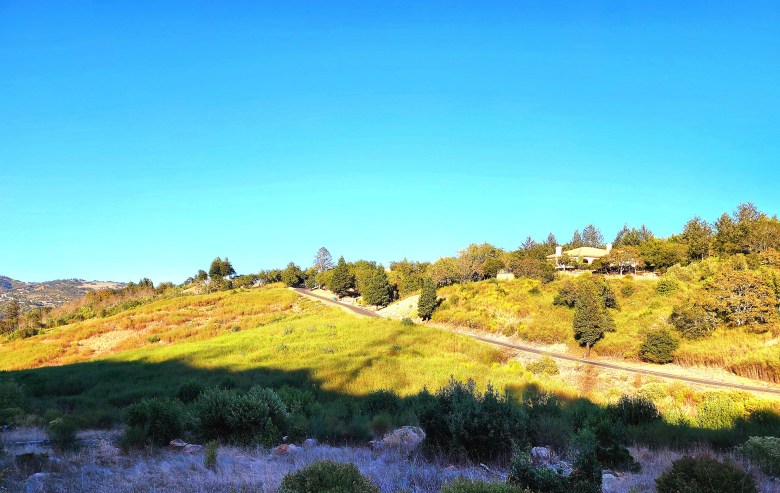 A hillside carpeted with invasive Scotch broom slopes up to a cluster of homes in the Santa Rosa, Calif., development, Fountaingrove, on Tuesday, Oct. 7, 2025. (Glen Martin via Bay City News)
A hillside carpeted with invasive Scotch broom slopes up to a cluster of homes in the Santa Rosa, Calif., development, Fountaingrove, on Tuesday, Oct. 7, 2025. (Glen Martin via Bay City News)
But Rice also cautions that “mechanical” fuel removal isn’t enough. For genuine security, communities must fight the fires of the future with fire now – “prescribed” fires that ideally burn low and slow and meander about, placidly consuming dead fuels and closely-spaced saplings. Prior to the adoption of widespread and aggressive fire suppression policies, megafires were rare: low-level fires sparked by lightning strikes, indigenous people or ranchers consumed dead limbs, leaf litter and small trees, eliminating heavy wildland fuel loads and creating forests of large, widely spaced – and fire-resistant – trees.
Fire managers are widely cognizant of this fact and are attempting to re-introduce fire to the WUI. The process can be time-consuming, labor intensive and expensive, and it is sometimes met with homeowner resistance – but when it is done properly and regularly over significant time spans, the results can be spectacular, said Rice.
“I recently visited Fort Hunter Liggett [a military post] on the Central Coast,” Rice said. “Prescribed fire has been used there for decades. It was wonderful – a landscape of huge valley oaks and grasslands. It was what Central California looked like before widespread wildfire suppression.”
Prescribed fire may be more appropriate for the sparsely populated Glass Fire footprint than for the heavily developed region immolated by the Tubbs Fire, but the accelerating megafire phenomenon has wildfire experts working overtime to avoid disastrous re-burns in the ever-expanding WUI.
“We’ve had a lot of bad history, but a lot of good has come out of that,” said Lowenthal. “Our community is much more understanding of the need for defensible space than they were before the Tubbs Fire, and they’re much more prepared today to do what they need to do to increase home survivability. That involves ongoing fuel control, of course, but sometimes it’s something simpler – like closing your garage or house doggie door before a big wind event. You have an open doggie door, wind blows embers in, and you lose your home. So, yeah – we educate people on that as well as Scotch broom removal.”
This article first appeared at LocalNewsMatters here.
Related

